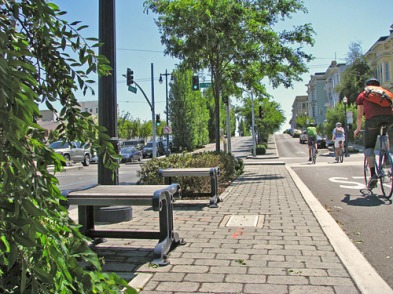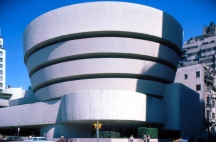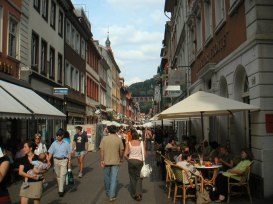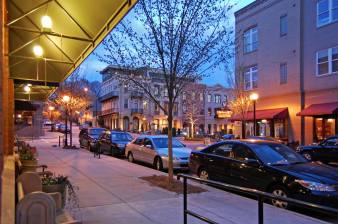By Dom Nozzi
May 19, 2008
I’ve read over the review comments by the Virginia Department of Transportation (VDOT) bicycle and pedestrian coordinator pertaining to the bike and pedestrian elements of the draft Downtown Richmond Master Plan. Before I provide my thoughts about his comments, I’d like to point out that I met the coordinator recently at a VDOT complete streets workshop. In my brief chat with him, I found him to be likeable, informed, and smart. He seemed to “get it.” I enjoyed talking with him.
I agree with the coordinator that a shared, narrow outside lane proposed in the plan on the extremely wide, hostile, high-speed Broad Street will not be suitable for bicyclists (even commuter bicyclists). Broad Street would need fairly substantial redesign to induce low-speed motor vehicle travel in order for a shared lane to work on Broad. As far as I know, this sort of needed redesign has not been proposed by the plan. Until that happens, I agree with the coordinator that routes parallel to Broad need to be designated and designed, if necessary, for bicycling.
I agree with the coordinator that the Fan District needs more traffic calming mechanisms than are called for in the plan. The streets are overly wide, and encourage excessive motor vehicle speeds. On a related note, I agree with the coordinator that the frequent (and in my opinion, misguided) use of stop signs in the Fan for traffic calming is counter-productive. I agree with the coordinator that bulb-outs could be a better treatment for a number of intersections.
I strongly disagree with the coordinator that one-way streets are beneficial in the downtown area (he cites the benefits of reducing peak-hour congestion). In my view, he is speaking as a suburban motorist rather than a downtown bicycle commuter when he urges the use of one-ways. In my professional opinion (and as a life-long bicycle commuter and whose master’s thesis subject was bicycle travel), one-ways degrade property values, induce higher-speed car travel (due to reduced “friction”), reduce pedestrian comfort, increase motorist impatience with bicyclists and other motorists, harm retail, increase  sidewalk bicycle riding, promote sprawl housing by speeding commuters into and out of downtown jobs, increase inconvenience for bicyclists and motorists (especially for visitors to the city), and increase wrong-way bicycle riding. I am a bicycle commuter in Richmond, and I find myself being obligated to wrong-way ride nearly every day.
sidewalk bicycle riding, promote sprawl housing by speeding commuters into and out of downtown jobs, increase inconvenience for bicyclists and motorists (especially for visitors to the city), and increase wrong-way bicycle riding. I am a bicycle commuter in Richmond, and I find myself being obligated to wrong-way ride nearly every day.
In my opinion, the most essential thing that Richmond can implement from the draft Master Plan is the conversion of one-ways to two-way. No other recommendation in the Plan is so important and so potentially beneficial to the city.
I would note, as an aside, that there are no one-way streets in suburbia, in part because they are considered undesirable for suburbanites to live on. “One-way streets are okay, but only in your neighborhood, not mine.”
Another aside: Having been a bicycle commuter since I was a boy, and having lived in a great many communities as a bicycle commuter, my assessment of Richmond is that the city street system is relatively hostile to bicyclists. I have found that, by far, the most important reason that Richmond is not bike-friendly is the one-way street system. I am therefore astonished that the bike/ped coordinator supports them.
I disagree that the draft plan does not adequately address the needs of bicyclists.
By the way, I’d like to note here that the consultants propose using a “transect” system for the regional design of land uses and streets. This is a wonderful idea that the City needs to heartily embrace. Such a system requires that design be context-sensitive, and provides designs for the full range of lifestyle choices. There is a rural/peripheral/conservation zone at the edge of a community, suburban zones, and compact, low-speed, walkable urban zones. Speeds and dimensions increase as one moves from the urban zones to the suburban to the rural zones. Promoting quality lifestyles for each of those zones therefore requires design that is calibrated for each zone. That is, design is context-sensitive. For bicycling, for example, this means that in properly low-speed downtowns, bicyclists tend to be comfortable sharing the lane with cars. Painted bike lanes are unnecessary (and often counter-productive to the low-speed, human-scaled ambience). As speeds and sizes increase in suburban zones, bike lanes become more necessary. In rural zones, the highest speeds here often require fully separated bike paths.
My speculation is that the coordinator is unfamiliar with this transect concept, and his comments seem to suggest that he supports use of designs which I will here call “transect violations.” That is, he seems to inappropriately call for the use of bike lanes in the low-speed Richmond downtown. In a low-speed downtown environment, the lifestyle and design imperative is the pedestrian. Bike lanes can degrade this walkable lifestyle design intent by subverting the potential for future (and needed) street narrowing, and increasing motor vehicle speeds.
I agree with the coordinator that the increased bike parking called for by the plan is not a meaningful way to promote increased bicycling. I would note, however, that despite the fact that bike parking does not significantly increase bicycling, bicycle parking is an important way for the community to send a visible public message that the community recognizes, respects and supports bicycling.
I disagree with the coordinator that the transportation consultant (HPE) “doesn’t ‘get it.'” Indeed, in my many years of looking over bike/ped plans, these are some of the very best I’ve seen, despite what the coordinator indicates. Again, I think the problem here is that while the consultant is designing for a low-speed, walkable environment (downtown), the coordinator is thinking about the design necessary in higher-speed suburban applications.
The coordinator points out that the plan is woefully inadequate in its bicycling recommendations for downtown Richmond. Speaking as an urban designer and bicycle commuter, I find the recommendations to be adequate, appropriate and impressive. As the consultant notes, in a compact, low-speed environment, bicycling does quite well without the need for special treatments such as bike lanes (bicyclists tend to be able to comfortably “fend for themselves,” so to speak, in compact, low-speed environments).
It is therefore appropriate that the plan, in designing for a high-quality, low-speed, pedestrian-oriented downtown, devotes nearly all of its design focus on the pedestrian. Happily, properly designing for a quality low-speed environment for pedestrians also happens to be an effective way, indirectly, to improve conditions for bicycle commuting.
I would note that the coordinator makes almost no substantive comments regarding pedestrian design needs.
 pedestrians crossing (or wanting to cross) mid-block, rather than at intersections. To design for that inevitability – and to support the low-speed design we need for this section of north Broadway – the design needs to include raised medians along the street. Raised medians reduce average car speeds, increase motorist attentiveness, substantially shorten pedestrian crossing distances, and promote street beautification. I therefore believe raised medians should be included in the Community Cycles recommendation.
pedestrians crossing (or wanting to cross) mid-block, rather than at intersections. To design for that inevitability – and to support the low-speed design we need for this section of north Broadway – the design needs to include raised medians along the street. Raised medians reduce average car speeds, increase motorist attentiveness, substantially shorten pedestrian crossing distances, and promote street beautification. I therefore believe raised medians should be included in the Community Cycles recommendation.


 are so angry that they lump the car advocates with the walkability advocates. ALL are evil, even if some have the remedy we need. It leads to gloom when one thinks about our prospects.
are so angry that they lump the car advocates with the walkability advocates. ALL are evil, even if some have the remedy we need. It leads to gloom when one thinks about our prospects. spaced pedestrian bridges over the creeks (say, every 200 feet, as we often call for such cross-access distances within a block).
spaced pedestrian bridges over the creeks (say, every 200 feet, as we often call for such cross-access distances within a block).

 sidewalk bicycle riding, promote sprawl housing by speeding commuters into and out of downtown jobs, increase inconvenience for bicyclists and motorists (especially for visitors to the city), and increase wrong-way bicycle riding. I am a bicycle commuter in Richmond, and I find myself being obligated to wrong-way ride nearly every day.
sidewalk bicycle riding, promote sprawl housing by speeding commuters into and out of downtown jobs, increase inconvenience for bicyclists and motorists (especially for visitors to the city), and increase wrong-way bicycle riding. I am a bicycle commuter in Richmond, and I find myself being obligated to wrong-way ride nearly every day. ing low-speed town center. On-street parking should therefore be included whenever
ing low-speed town center. On-street parking should therefore be included whenever pedestrians, but bicyclists, transit, retail, residential, children, seniors, well-behaved motorists, the disabled and everyone else.
pedestrians, but bicyclists, transit, retail, residential, children, seniors, well-behaved motorists, the disabled and everyone else. new utilitarian bike and pedestrian trips are the enormous distances one finds in low-density, single-use suburban settings.
new utilitarian bike and pedestrian trips are the enormous distances one finds in low-density, single-use suburban settings.
